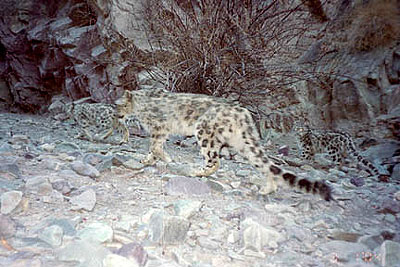Wild Snow Leopards

The photograph above demonstrates (as so many camera-trap photos do) how the snow leopard’s pelage lets them disappear into background. How many snow leopards do you see? That’s right, there is a female and two cubs in the photograph.
Cubs are born in late spring-early summer when the wild sheep and goats are also giving birth, so food is more plentiful for the new cat family. Snow leopards, especially young ones learning to hunt, also eat game birds and small mammals such as marmots, hares, and pikas. Even so, it must be very hard for a mother snow leopard to feed herself and two hungry youngsters.
As Darla wrote in Vanishing Tracks: one of our radio-collared females stayed in or near her den during much of June 1984. A year later we watched her walk along a far hillside with her two big cubs. The cubs played as if they were kittens, chasing one another, rolling and tumbling down the steep hill. They stalked imaginary sheep. They leaped and charged while their mother padded along. She was well aware of the small herd of blue sheep well aware of them on the slopes above. If she was hungry, too bad; none of those sheep would become leopard food, thanks to the boisterous cubs!
We still have to rely on zoos for most of what we know about snow leopard “family life.” Zoo-dwelling cats have as many as four cubs after a gestation period of 90-100 days. Such large litters may be possible because the food is steady and reliable, without the mother having to spend her energy hunting. We can’t say for sure what an average litter size would be in the wild. We know that snow leopards can raise up to four cubs, but believe that in the wild two is more usual. Litter size may depend on the availability of prey, how healthy and strong the mother is, or some other factors..